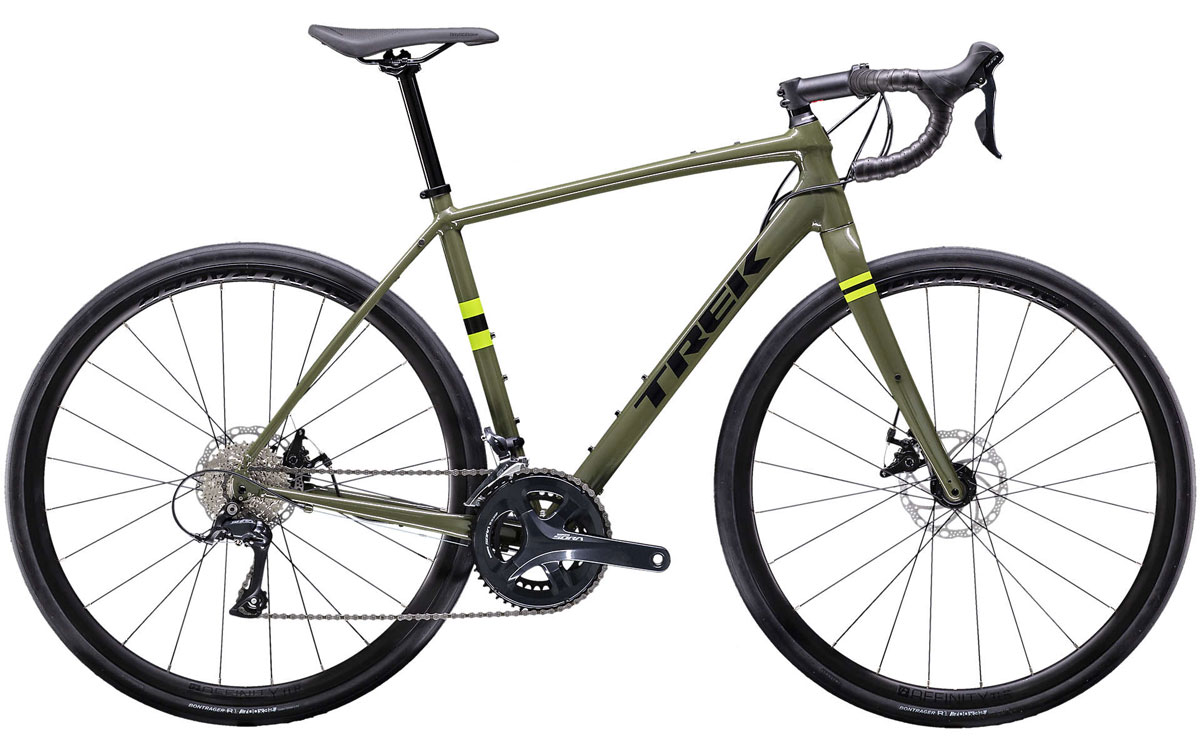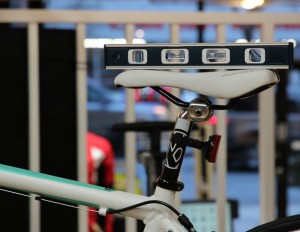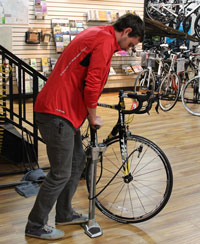
Test-riding Road Bikes
So you’ve decided you want a new road bike, and plan to test-ride a couple. Here’s a few things that will help you get a fair comparison and make the right choice! Note that this article is entirely brand & material neutral, but altruism aside, we’d still like you to buy your next bike from Chain Reaction in Redwood City California. 🙂
What the shop will require

First, a couple things to keep in mind. You’re going to be taking a spin on something that’s reasonably expensive, so assume the shop’s going to require you to leave something valuable that ensures your return. In our case, it’s a valid current California driver’s license and a credit card. This works because it verifies who you are and it’s something we can be reasonably sure you’ll return to get (even though some of us have some rather dreadful photos that we’d rather not see again!). We will also create a record in our computer of the bike being ridden. We used to be a bit more liberal and skip the credit card part, but we’ve had to tighten up a bit due to a string of test-ride bike thefts in the area.
Also, please note that most shops (including Chain Reaction) will not allow test rides if the pavement is damp or it’s even getting close to dark (assume you need to arrive at least one hour prior to closing or one hour prior to sundown, whichever is earlier). Your safety is more important to us than selling a bike.
What you should bring
Many shops, including ours, require helmets on test rides. We just think it’s a good idea to try and keep you alive, at least until we sell you the bike! And no, it has nothing to do with insurance. If you’ve already got a helmet, bring it with you…it’s probably already set up correctly for your head and will save some time.
If you’ve already got clipless pedals from another bike, bring your shoes with you! It’s much better to test ride a bike the way you’re used to riding. If the pedal system is something other than standard SPD (the typical mountain-style recessed-cleat pedal/shoe system), then bring along your pedals as well, and have them installed on whichever bike you ride. And if you’ve got cycling shorts (which you should, since they make cycling much more comfortable), bring those too. You want to be testing out the bike and not be distracted by uncomfortable clothing etc.
How the bikes should be set up
OK, you’ve figured out a couple bikes you’d like to ride. Remember, you want to test each bike under optimal conditions, so here are some things to make sure of-
 #1: For the first bike, make sure the seat is adjusted properly…both for height and tilt. The nose of the seat should be level with the back, and even small variations here can make tremendous differences in comfort. Once you have the seat height figured out, have it measured (from center of crank to the top of the saddle) and set up each subsequent bike to exactly the same height. This is very important, as even small changes in seat height can have a dramatic effect on how a bike feels…and you’re testing a bike, not a saddle position! (For more info about saddles and bike fit, we have an article on line)
#1: For the first bike, make sure the seat is adjusted properly…both for height and tilt. The nose of the seat should be level with the back, and even small variations here can make tremendous differences in comfort. Once you have the seat height figured out, have it measured (from center of crank to the top of the saddle) and set up each subsequent bike to exactly the same height. This is very important, as even small changes in seat height can have a dramatic effect on how a bike feels…and you’re testing a bike, not a saddle position! (For more info about saddles and bike fit, we have an article on line)
#1b: It may be possible for a skilled salesperson to take a quick look at your position on the bike, with your hands on the lever hoods (where you’ll be spending most of your time with STI levers) and notice that you’ll definitely need a shorter, or longer, stem (the part that holds the handlebars to the fork). In some cases, this change can be made very quickly, due to new stem designs that allow you to change the stem without having to remove & reinstall the brake levers and handlebar tape. It’s definitely in the best interest of the shop to make your ride as comfortable as possible, so don’t be surprised if this is done before you take your test ride.

#2: Have each bike’s tires inflated to appropriate pressure, right in front of you. This is as important, if not more so, than the saddle height. If you ride the ultimate carbon-framed bike with its tires carrying only 70psi, vs a much-less-expensive machine with its tires running at “normal” pressure (100psi), can you guess which is going to have a faster ride??? I recognize that this is going to annoy a whole lot of salespeople, who will pinch a tire with their fingers and say it’s fine, but this is a really important point. A tire even 10psi low is not giving you the ride you need. Always test tire pressure before you ride, with a gauge.
#3: Ask if the salesperson could run you through the gears on a stand, just to make sure you know how they’re supposed to work (which you probably do) and to ensure that they’re properly adjusted. There are a lot of reasons why a new bike might not have perfectly-adjusted gears (including kids playing with the levers when the bikes are in the rack), but we don’t care about the “why” for now. We just want to make sure things will work the way they’re supposed to on the test ride!
The actual test ride
Now you’re ready for your test ride. Question is, where? We have basically three types of test rides…the classic “parking lot” ride, the “around the block” ride, and the longer 4-mile “road” ride. The parking lot cruise is useful for having the salesperson check out your position on the bike and, in some cases, is as much of a ride as a customer feels comfortable with (because they don’t want to deal with traffic etc.). Usually, after graduating successfully from the parking-lot ride, you’ll want to take it on a bit longer spin around the block, getting up some speed on the straightaways, or maybe just feeling better because you don’t have a salesperson looking at you while you’re riding. [By the way, for the parking lot ride, it might be OK to use normal street shoes on clipless pedals, but for anything more, make sure the pedals are compatible with your shoes! We keep quite a few standard toe-clip pedals around for just this purpose.]
We have a four-mile test-ride loop that includes good pavement, bad pavement, hills, descents and maybe even a combination of head & tailwinds. What more could you ask? We even give you a map showing the course, and ask that you stay on it. Why? Because if something were to happen to you, we need to know where to go looking! Remember, you’re on someone else’s expensive machine, and we have an interest in keeping both the bike, and you, safe.
At this point you may have fallen in love and confirmed your suspicions that this is the bike for you! But if that’s not the case and you want to test ride another bike, make sure that the seat height is set up exactly the same as it was on that first bike, and have the tires aired up, and run through the gears again. By the way, I should explain that tires in high-quality bikes have a normal tendency to lose a fair amount of air over a couple week’s time, so it should not be a surprise when they need air…it should be expected.
How to compare different bikes…what to look for
Afraid you won’t be able to tell much difference between two bikes? Even if you’re inexperienced at cycling, my guess is that the differences will be more obvious than you think!
And what should you look for? Check out for how each bikes accelerates while sitting and standing, comfort over big bumps, how it handles road buzz (vibration from “grainy” road surfaces) and any sort of emotional appeal it might have (how’s that for a vague quality?). For longer rides, we strongly recommend that you find a small hill you can charge up. Why? Because there’s nothing that separates a great bike from an also-ran like a hill. A really great bike just feels like it wants to go, even climb, even when you’re not in the right gear. An also-ran will have you constantly searching for that right gear, that sweet spot where everything comes together (hopefully). The really great bike just doesn’t care…it simply performs. If you’re in Kansas or Florida and the closest hill is 100 miles away, maybe an overpass will work…
For more info on the differences between one bike and the next, you can check out our articles on such things as whether a bicycle has a soul, how durable is carbon fiber, should you buy the cheapest bike with the best parts and many others in the menu section at the bottom of each page of this website.
You’ve found the right bike…now what?
You’ve found your bike…it’s got the right features, feels great while riding, etc. Now you need to get measured for proper fit. The frame size on what you rode might be correct… then again, it might not. At Chain Reaction, we use the New England Cycling Academy’s FitKit system, which takes a series of measurements of the rider, to make sure we have not only the correct frame size, but top-tube plus stem distance (critically important and frequently ignored!), seat-to-handlebar drop, seat height, handlebar width and more. It’s not a matter of how much clearance you have standing over the frame! That might help get you in the ballpark, but since the front-to-back distance of a frame changes with size, your arm & torso measurements might dictate a frame size different than standover height might indicate.
Please note that, in the majority of cases, the stem length on the bike will need to be changed. This isn’t a big deal if the shop sells a lot of road bikes…they’ll have the various stems in stock and ready to go. I would suggest that any shop not willing to swap the stem for proper fit on a road bike may not be a good place to buy one! In many cases there will be no charge for a stem swap, but there will be times where you have to go to a stem that might cost a bit more, or perhaps because it’s a lot higher they might need to replace several cables & housings, which definitely takes a lot of time. Or it might be a closeout bike that came with a ridiculously-long & low stem that has no value to the shop. In those cases, you could expect to pay a small amount of money to cover the difference and/or the labor involved.
Fortunately, at Chain Reaction we have such a tremendous number of road bikes in stock that there’s rarely an issue getting someone set up with exactly the right size bike, right then and there. But Chain Reaction, with over 300 road bikes in stock at any one time, is not exactly typical, so don’t be surprised if getting the proper fit involves waiting for one to come in. It will be worth the wait, especially if the alternative is a bike that doesn’t feel quite right because the fit’s wrong. If your local shop doesn’t have a zillion road bikes in stock, that’s not necessarily an indication that they’re not serious about road bikes…could be they just don’t have such a highly-developed road bike market like we do in the SF Bay Area, and can’t afford to have a huge number of bikes sitting around, waiting for you. Not a problem for us…the number of road bikes we sell would make most shops heads spin.
After you find your new dream machine, you might check out our Taking Care of your Road Bike article.
Interested in our sale-priced bikes? Check here! And don’t forget to join our email-list so you’re up-to-date on our latest specials.
–Mike–